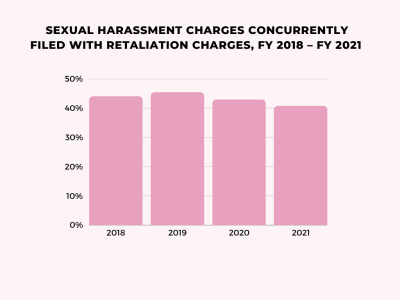How to Navigate the Legal Landscape of Workplace Sexual Harassment – Guest Post

Workplace sexual harassment is an unfortunate reality that affects far too many employees. However, there are legal protections and frameworks in place to help prevent harassment and address it properly when it does occur.
This blog post delves into the crucial legal landscape surrounding workplace sexual harassment, dissecting the stringent laws and guidelines that employers must navigate. This post underscores the uncompromising responsibilities placed on employers and sheds light on the severe consequences that loom over those who dare to flout compliance.
Sexual Harassment and Abuse in the Workplace: A Grim Reality
Workers across various industries encounter incidents of sexual harassment. Between fiscal years 2018 and 2021, the EEOC registered a substantial 98,411 confirmed charges related to harassment across different bases. Among these cases, approximately 27,291 charges specifically accused individuals of sexual harassment. These statistics unequivocally highlight the persistent and prevalent nature of sexual harassment in today’s workplaces.
What compounds this issue is that these statistics represent only reported cases, implying that the actual extent of the problem might be even more pervasive.
All industries face sexual harassment but some industries see higher prevalence than normal. Industries with significant sex and gender bias such as religious institutions and finance may face disparities in pay and harassment. If you are facing such issues in the clergy and require legal assistance, consider contacting a clergy sex abuse lawyer. They can provide guidance and support tailored to the unique challenges within this specific industry.
Understanding the Legal Framework
There are a few key laws and regulatory bodies that address the issue of sexual harassment in the workplace.
Federal Laws
At the federal level in the United States, Title VII of the Civil Rights Act of 1964 prohibits discrimination based on sex. The Equal Employment Opportunity Commission (EEOC) enforces this law and handles charges related to sexual harassment. This law applies to religious institutions as well.
State Laws
In addition to federal regulations, many U.S. states have their own anti-discrimination and human rights laws. These laws may provide additional protections against sexual harassment or slightly different definitions of harassment. Employers and employees alike need to be aware of regulations in their specific state.
International Laws
For multinational companies, it’s also essential to consider regulations in other countries where they have offices or employees.. For example, India’s Sexual Harassment of Women at Workplace (Prevention, Prohibition and Redressal) Act 2013 has clear guidelines around sexual harassment policies, complaint committees, and penalties for non-compliance.
Recognizing Types of Sexual Harassment
Sexual harassment can take many forms, so it’s crucial for both employers and employees to recognize inappropriate behaviors. Two key types of sexual harassment are:
- Quid pro quo – When favorable treatment or continued employment is conditioned on an employee granting sexual favors to their supervisor or someone with authority. Even the threat of retaliation for refusing advances can constitute harassment.
- Hostile work environment – When repeated or unwanted sexual jokes, touching, comments, gestures, or images create an intimidating or offensive workplace. A single incident typically isn’t enough to be illegal, but repeated occurrences can rise to the level of harassment.
Employer Responsibilities
Employers have a few key responsibilities when it comes to preventing and addressing sexual harassment:
- Internal policy – Have a clear, written anti-harassment policy that defines prohibited behaviors and includes reporting procedures. This policy should be regularly communicated to all staff.
- Complaint process – Establish a complaint process and investigative procedures. This often involves having complaint committees/teams in place.
- Training – Provide regular anti-harassment training to ensure all managers and staff understand expected behaviors and policies.
- Safety precautions – Take reasonable measures to prevent harassment or hostile environments for employees. This may include monitoring problematic areas in the workplace.
- Display of penalties – Clearly display information on disciplinary actions for harassment. This visibility can act as a deterrent to unacceptable behaviors.
Compliance with the Sexual Harassment Act
Given the legal responsibilities around sexual harassment, compliance should be a top priority for employers. Yet statistics indicate there is still work to be done. Between FY 2018 and 2021, sexual harassment charges accounted for 27.7% of all harassment charges received by the EEOC.
Here are tips for ensuring compliance:
- Implement policies – Have detailed sexual harassment prevention policies, complaint committees, reporting procedures, and disciplinary measures.
- Composition of committees – Ensure complaint committees have competent, unbiased members capable of appropriately investigating allegations.
- Awareness programs – Conduct awareness workshops so all employees understand policies and commit to a harassment-free workplace.
Consequences of Non-Compliance
Failing to comply with regulations carries significant legal and financial risks, including:
- Fines – Fines are the usual punishment for sexual harassment cases with liable parties being fined thousands of dollars in damages.
- Lawsuits & settlements – There is the risk of costly lawsuits or settlement payouts to victims if complaints aren’t handled properly. Average payouts can exceed $100k.
- Reputation damage – Legal cases or accusations related to harassment can severely damage an organization’s reputation and ability to recruit talent.
In essence, non-compliance opens the door to major liabilities.
Frequently Asked Questions (FAQs)
What legal protections exist for victims of workplace sexual harassment?
Federal laws like Title VII and state anti-discrimination laws prohibit sexual harassment and provide legal recourse if it occurs. Victims can file formal complaints with the EEOC or a state agency requesting an investigation.
What penalties can employers face for non-compliance with sexual harassment regulations?
An employer that fails to adequately prevent/address sexual harassment can face fines of over $50k or be liable for settlement payments to victims that often exceed $100k. Lawsuits can also severely harm a company’s reputation.
How should employees report sexual harassment incidents in the workplace?
Employees should document details of any harassing behaviors and report the incidents per their employer’s complaint procedures. Most policies direct employees to report issues to a human resources representative, supervisor, or designated team responsible for investigating harassment claims.
Final Takeaway
Workplace sexual harassment remains an ongoing issue that companies cannot afford to ignore or handle incorrectly. By understanding the legal landscape – including federal, state, and international regulations – employers can educate themselves on compliance requirements. Taking proactive and preventative measures is equally essential. With the appropriate awareness, policies, complaint procedures, and disciplinary measures in place, companies can strive to provide safe and respectful workplaces for all. The costs of non-compliance are simply too high, for both employers and employees alike.



Recent Comments